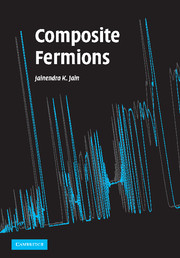Book contents
- Frontmatter
- Contents
- Preface
- List of symbols and abbreviations
- 1 Overview
- 2 Quantum Hall effect
- 3 Landau levels
- 4 Theory of the IQHE
- 5 Foundations of the composite fermion theory
- 6 Microscopic verifications
- 7 Theory of the FQHE
- 8 Incompressible ground states and their excitations
- 9 Topology and quantizations
- 10 Composite fermion Fermi sea
- 11 Composite fermions with spin
- 12 Non-composite fermion approaches
- 13 Bilayer FQHE
- 14 Edge physics
- 15 Composite fermion crystals
- Appendixes
- References
- Index
7 - Theory of the FQHE
Published online by Cambridge University Press: 07 December 2009
- Frontmatter
- Contents
- Preface
- List of symbols and abbreviations
- 1 Overview
- 2 Quantum Hall effect
- 3 Landau levels
- 4 Theory of the IQHE
- 5 Foundations of the composite fermion theory
- 6 Microscopic verifications
- 7 Theory of the FQHE
- 8 Incompressible ground states and their excitations
- 9 Topology and quantizations
- 10 Composite fermion Fermi sea
- 11 Composite fermions with spin
- 12 Non-composite fermion approaches
- 13 Bilayer FQHE
- 14 Edge physics
- 15 Composite fermion crystals
- Appendixes
- References
- Index
Summary
The central postulate of composite fermion theory is that the liquid of strongly interacting electrons in a high magnetic field B is equivalent to an assemblage of weakly interacting composite fermions in an effective magnetic field B*. The effective magnetic field is such a direct, fundamental, and dramatic consequence of the formation of composite fermions that it is taken as the defining property of composite fermions, and its observation is tantamount to an observation of composite fermions themselves. Computer experiments on small systems, described in Chapter 6, demonstrate that the dynamics of interacting electrons in the lowest Landau level resembles that of weakly interacting fermions in an effective magnetic field. The present and the subsequent chapters analyze numerous experimental facts within the CF theory. We begin with the explanation of the FQHE.
Comparing the IQHE and the FQHE
Compelling evidence for composite fermions comes from the simple act of plotting the FQHE data as a function of the effective magnetic field B*, which amounts to rigidly shifting the B-axis by a constant (B – B* = 2pρø0), and then comparing it to the IQHE of electrons, which is a system of weakly interacting fermions. To facilitate comparison for samples with different densities, we plot the resistance trace in the IQHE as a function of 1/ν, which is proportional to B, and compare it with the resistance trace in high magnetic field plotted as a function of 1/ν*, which is proportional to B*.
- Type
- Chapter
- Information
- Composite Fermions , pp. 201 - 216Publisher: Cambridge University PressPrint publication year: 2007

